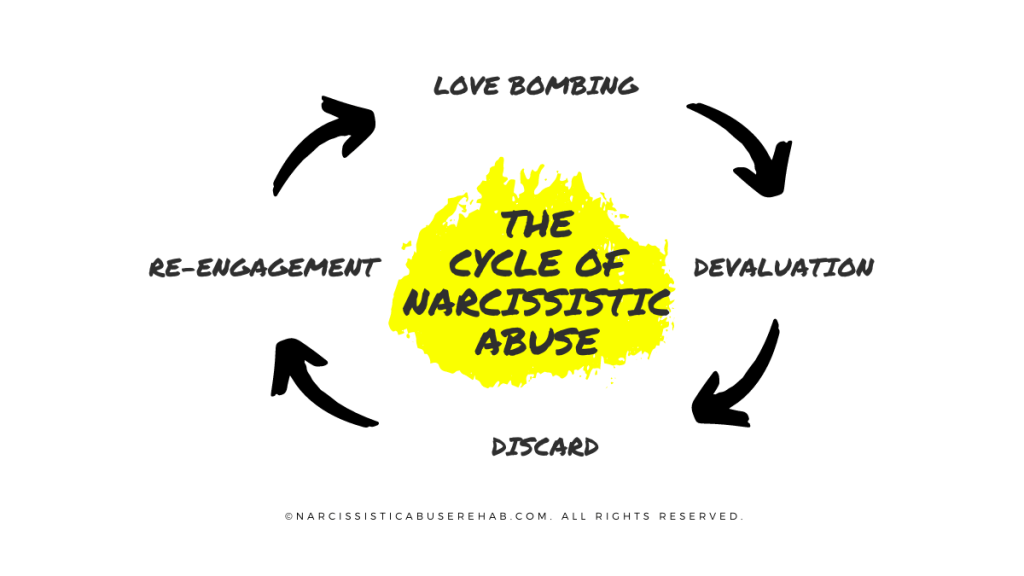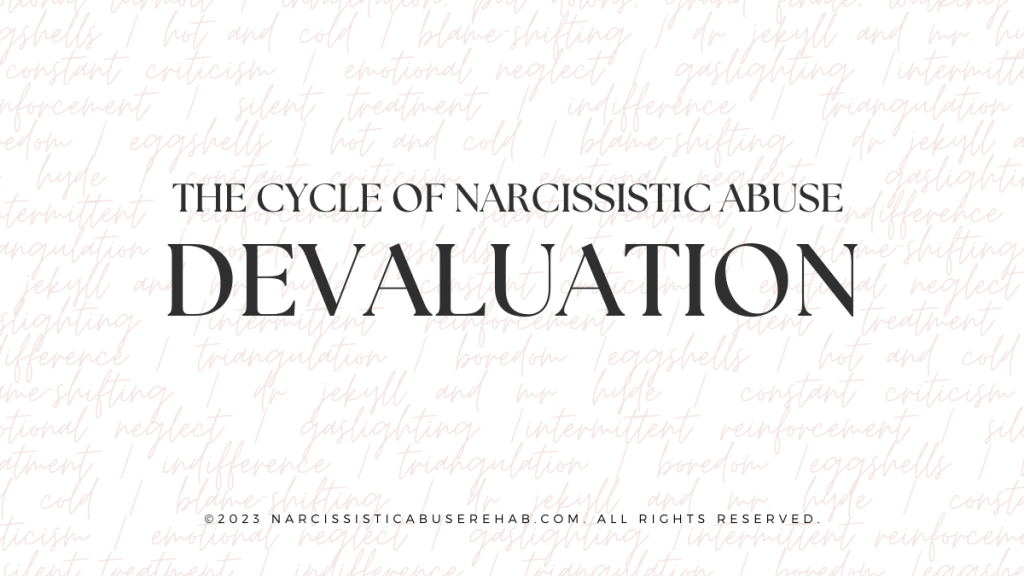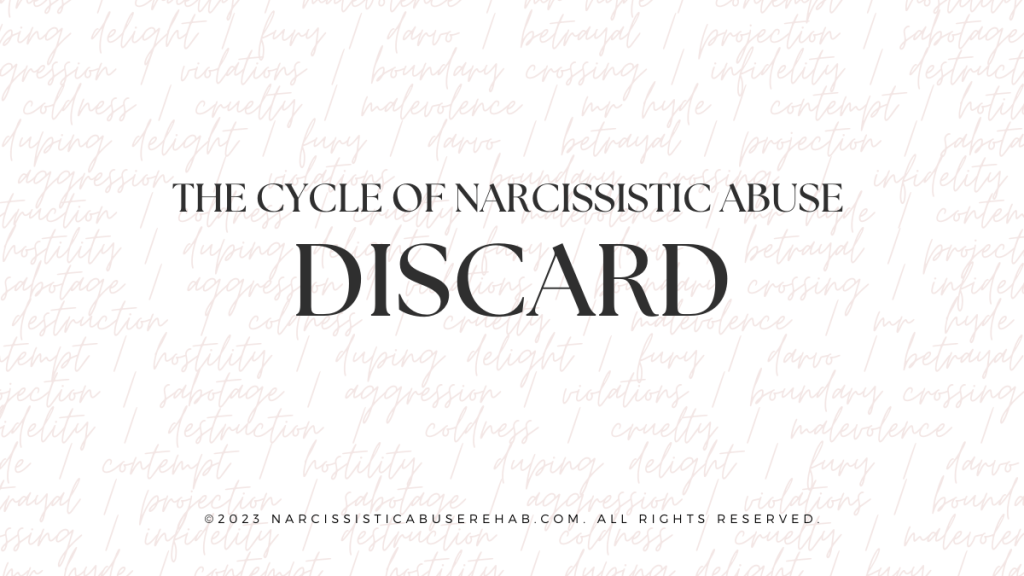The cycle of narcissistic abuse is a pattern of harmful behaviors used by one person to manipulate and exploit another. It usually consists of a four-stage pattern: idealization, devaluation, discard, and hoover. Psychiatrist and psychoanalyst Dr. Thomas Franklin, MD shares his expertise on this topic. He is a member of the Group for the Advancement of Psychiatry, the American College of Psychiatrists, and the faculty of the University of Maryland School of Medicine.
This article discusses:
- Definition
- Idealization
- Devaluation
- Discard
- Re-Engagement
- Vulnerabilities
- Health impact
- Signs
- Breaking Free
- Recovery
What is the Cycle of Narcissistic Abuse?

The cycle of narcissistic abuse commences with the idealization phase, then progresses to devaluation, which is subsequently succeeded by the discard phase. Afterward, the cycle resumes with the hoover stage. It is a repetitive pattern used by the perpetrator to manipulate, exploit, and subjugate the victim for personal gain. Moreover, while specific motives may differ among perpetrators, common objectives involve asserting power, exercising control, and fulfilling narcissistic desires. Ultimately, the overarching aim of narcissistic abuse is to entrap the victim within the intricate web of manipulation.
“The narcissistic abuse cycle often involves idealization and devaluation, which becomes chronic. Ultimately it leads to discarding the person that has been wrung out and is no longer the new shiny object that made the narcissist feel special in the first place. Often these chaotic, aggressive relationships involve other character pathology, including borderline and sociopathy.”
Dr. Thomas Franklin
By traversing through the various phases, the perpetrator sustains a profound sense of power and control over the victim’s emotions, thoughts, and behaviors. This cyclical pattern serves as a mechanism through which the perpetrator fosters a persistent state of dependency within the victim which they use to establish dominance and act out expressions of abusive power and control.
Idealization

Idealization is the initial stage of the narcissistic abuse cycle. It sees the perpetrator meticulously weaves a deceitful web to ensnare their unsuspecting prey. The victim is lavished with attention, charm, and performative devotion. They are beguiled by a symphony of compliments and promises. The perpetrator uses a tactic called future faking to paint an idyllic picture of a secure and ideal union. The victim is seduced and placed on a high pedestal where they are touted as the center of the perpetrator’s universe. The victim feels seen, heard, and treasured. Their dreams are seemingly fulfilled.
The more narcissistic someone is, the more they are prone to see people as objects. Consequently, during the love bombing stage, perpetrators of narcissistic abuse view and treat their victims as a positive object and hold them in high regard.
“People want to think people are at the core their best selves, so when things start going south, someone who has been love-bombed by a narcissistic character presumes that things will get back to that when this isn’t at all the case.”
Dr. Thomas Franklin
The perpetrator’s underlying message during the idealization phase is You remind me of me. You reflect the qualities I associate with my idealized self-image. The perpetrator engages with the victim as the delightful Dr. Jekyll persona they use to mask the odious Mr. Hyde at their core.
Common Manipulation Tactics During Idealization

- Counterfeit concern. The perpetrator will deceptively display care or empathy for the victim, to gain trust, control, or to further their personal agenda.
- Data Mining. Victims often experience perpetrators expressing an unusual level of interest and curiosity in their preferences, dreams, and goals, as the perpetrators gather information to uncover their wants, needs, and vulnerabilities. This data mining enables the perpetrators to gain insights into the victim’s characteristics, strengths, weaknesses, and intentions, shaping their seduction strategy based on what they learn.
- False Self. Based of the information collected by data mining and mirroring, the perpetrator constructs an alter ego to reflect the victim’s ideal partner. It involves presenting a façade or mask that differs from the perpetrator’s authentic self. Moreover, it is used to gain acceptance by camouflaging the perpetrator’s predatory nature.
- Future faking. The victim is given false promises or commitments by the perpetrator about an idealized future to gain their trust or keep the victim invested. The perpetrator paints a picture a positive vision of what’s to come, but with no genuine intention of following through.
- Love bombing. The victim is placed on a figurative pedestal by the perpetrator, who manipulates them into believing that they are soul mates, twin flames, or kindred spirits with intense and relentless attention. The victim is showered with flamboyant displays of adoration and flattery. The victim’s wants and needs are recognized and attended to causing them to become emotionally dependent on the perpetrator. The aim of love bombing is to gain the victim’s trust, lower defenses, and establish an intense connection. The behavior is akin to the deliberate fattening of livestock prior to their eventual slaughter.
- Mirroring. In the context of narcissistic abuse, the victim’s words, actions, body language, and behaviors are imitated by the perpetrator. The purpose of the mirroring tactic is to cause the victim to feel strongly identified with the perpetrator, who essentially reflecting the victim’s winning qualities back to them to invoke familiarity. Mirroring rapidly establishes rapport, builds trust, and create a sense of connection between people. It fosters a sense of unity and understanding between the victim and the perpetrator.
- Pathological lying. Perpetrators are prone to compulsive deception. Their deceptions are invariably self-enhancing. They lie to manipulate others and to lull any suspicions to sleep. Lies are the foundation of the false persona they create to seduce the victim. For example, they may invent a false narrative about their past and claim to be have been victimized themselves at some point.
Hence, the idealization phase is the proverbial Trojan horse perpetrators of narcissistic abuse use to traverse the victim’s defenses and infiltrate their inner world.
Devaluation

The devaluation phase of narcissistic abuse plunges the victim into a distressing abyss of emotional turmoil. Once the perpetrator’s idealized facade crumbles, a stark transformation occurs, revealing a cruel and calculating nature. In this phase, the abuser systematically erodes the victim’s self-esteem, belittling their achievements, criticizing their every move, and inflicting psychological wounds. Insults, gaslighting, and constant put-downs become weapons used to undermine the victim’s sense of self-worth. The devaluation phase seeks to diminish the victim’s confidence, leaving them bewildered, shattered, and questioning their own sanity. It is a calculated assault on their identity, leaving them vulnerable and primed for further manipulation.
This is the phase when intermittent reinforcement is used to condition the victim to accept abuse and foster trauma bonds. The perpetrator is hot and cold with the victim. They withdraw the validation, approval, and rapport that characterized the idealization phase. Instead, there is criticism, invalidation, put downs, and anxiety. The victim becomes increasingly anxious and distressed. They find themselves walking on eggshells, ever frightened of triggering the perpetrator and desperate to appease them.
“Some of the behaviors present in the devaluation stage include cutting off people from their friends and loved ones, deeply personal attacks, grandiose apologies, and sometimes accelerating substance abuse with the person.”
Dr. Thomas Franklin
Generally, the perpetrator’s underlying message during the devaluation phase is Why can’t you be more like me? You’re failing to reflect the qualities I associate with my idealized self image!
The perpetrator oscillates with increasing frequency between Dr. Jekyll and Mr. Hyde, giving the victim harrowing glimpses of the sinister stranger behind the soul mate mask.
Common Manipulation Tactics During Devaluation

- Blame-shifting. When confronted about their behavior the perpetrator redirects blame onto others or external factors in order to evade accountability.
- Constant criticism. The victim is subjected to a continuous stream of negative feedback, disparaging remarks, and judgmental comments, which erode their self-esteem, creating a profound sense of worthlessness and emotional distress. The perpetrator further extends their criticism to encompass the victim’s family and friends, leaving the victim burdened with a deep sense of shame.
- Emotional Neglect. The victim no longer receives emotional validation, attention, and care from the perpetrator, causing them to feel unheard, disconnected, and taken for granted. The sudden and unexplained withdrawal of affection impacts the victim’s self-esteem and sense of self.
- Exploitation. The victim is taken advantage of by the perpetrator who uses their trust to make use of their access, resources and/or labor for their own benefit. It is done without concern for the victim’s human rights or well-being. The exploitation may be emotional, intellectual, economic, social or sexual.
- Gaslighting. When the victim confronts the perpetrator the are met with this tactic to undermine the their perception of reality and make them doubt their own thoughts, feelings, and experiences. The perpetrator denies facts in an attempt to alter the victim’s memories. The aim of gaslighting is to gain power and control over the victim by destabilizing their confidence and creating a state of confusion and dependency.
- Intermittent Reinforcement. The perpetrator blows hot and cold. One day they idealize the victim, the next they are completely indifferent. The victim becomes increasingly desperate to climb back on the pedestal and revert to the idealization stage, unaware that it was not sincere. The harder the victim tries to win back the affection of the perpetrator the more callous the perpetrator becomes.
- Isolation. The perpetrator’s manipulation will often lead to the victim cutting off treasured family members and friends. By isolating the victim, the perpetrator of the abuse to better able to control their access to information and influence their world view. As the perpetrator’s aggression escalates, the victim has no one to turn to.
- Silent Treatment. The perpetrator deliberately ignores or refuses to acknowledge the victim. They do no speak to them. It is a tactic used to exert control, power, and/or punish the recipient of the abuse. By intentionally withholding communication, the silent treatment can cause feelings of loneliness, anxiety, and emotional distress in the targeted individual.
- Triangulation. This is a divide and conquer tactic. The perpetrator creates and leverages a dynamic wherein the victim is pitted against others, causing conflict, chaos, and division. The perpetrator strategically uses a third party to undermine the victim’s confidence, fostering insecurity, competition and/or jealousy.
Discard

The discard phase of narcissistic abuse occurs when the manipulator abruptly withdraws their emotional investment and callously ends the relationship. During this phase, the perpetrator views the victims a devalued, negative object that must be ejected from their grandiose presence. The more narcissistic the perpetrator is, the more they coldly and cruelly they will treat the victim during the discard. There is no longer any need to hide their true nature so the false persona they used to infiltrate the victim’s life is dropped, leaving the horrified victim to find themselves dealing with the con artist behind the mask.
Gone is the soul mate. In their place is a mercenary stranger who treats the victim like a worthless inconvenience. Every moment of kindness and devotion is forgotten, leaving the victim shocked, hurt, and emotionally devastated. The perpetrator may display a complete lack of empathy or remorse. Flabbergasted and in deep emotional pain, the victim often discovers that the perpetrator has carefully planned the discard long before it happened.
“The discard can be dramatic but more often there is indifference or neglect. They are looking for a new shiny object and keeping you in the wings while they set about this.”
Dr. Thomas Franklin
There is likely to be an active smear campaign, preemptively launched by the perpetrator which is designed to destroy the victim’s credibility and make it impossible for them to be believed should they disclose their experiences with the perpetrator behind closed doors. Moreover, the perpetrator may have already moved on with an affair partner, who has taken the victim’s place on the coveted pedestal. A common behavior during this phase is duping delight as the perpetrator experiences profound satisfaction over successfully fooling the victim, bystanders, members of their social circle, authorities, etc. Other behaviors present during the discard are contempt, hostility, and/or fury, which are used to strike terror in the victim and thus control them.
During the discard phase, the victim is dealing solely with Mr. Hyde, who rejects the object on to which he has projected all of his flaws. During this phase, the perpetrator repeatedly hammers the ultimate insult into the victim’s head: You’re nothing like me! You don’t reflect the qualities I associate with my illustrious self image.
Common Manipulation Tactics During Discard

- DARVO (Deny, Attack, Reverse Victim and Offender). This is a manipulation tactic used to invalidate the victim’s disclosures. The perpetrator denies the allegations, attacks the credibility of the victim, and reverses the roles, portraying themselves as the victim instead.
- Betrayal. The victim’s trust will be repeatedly violated. Promises and commitments will be broken. The betrayal usually takes the form of infidelity, but it can also express in other ways, i.e. running up credit card debt in the the victim’s name and leaving them to deal with the fall out.
- Projection. The perpetrator disavows their undesirable thoughts, emotions, or traits by projecting them onto the victim. This includes internal conflicts, insecurities, or impulsive behavior. Through this cognitive distortion the perpetrator externalizing their faults and maintains the narcissistic self-deception that they are perfect.
- Sabotage. The victim’s progress and goals are deliberately undermined, obstructed by the perpetrator, who actively chips away at their self-esteem, withholds information, and engages in character assassination of the victim behind their back with gossip, rumor-mongering, exclusion, or social manipulation.
Re-Engagement

One might think perpetrators of narcissistic abuse would leave the victim alone after actively trying to destroy them. However, people who indulge in the cycle of narcissistic abuse tend to have low empathy or no genuine remorse for pain they cause others. Moreover, the perpetrators are well aware of the emotional dependency they meticulously cultivated in the victim, and they understand that a part of the victim may still yearn to reclaim their position atop the pedestal. Excessively narcissistic people revel in their ability to control others, and they often see it is as a testament to their superiority when they are able to successfully re-engage with a victim.
The re-engagement stage of the narcissistic abuse cycle is called the hoover maneuver or hoovering in popular psychology. It used to describe the perpetrator’s efforts to “suck” the victims back into the relationship after the discard phase, like a vacuum cleaner.
The underlying message of this phase of the abuse cycle is Remember me? Remember how good it felt when you reflected the qualities I associate with my grandiose self image? It aims to activate the powerful trauma bonds cultivated in the victim to make quick work of drawing the them back into the narcissistic abuse cycle.
Common Manipulation Tactics During Re-Engagement

- Feigned Remorse. The perpetrator may offer a disingenuous fauxpology, also known as a non-apology. It is entirely insincere and utilitarian. However, feigned remorse only ever goes so far and there will be countless excuses, justifications, and endless blame-shifting to avoid accountability.
- Idealization. (See above.)
- Jealousy-baiting. The perpetrator purposely attempts to provoke feelings of jealousy in the victim. They engage in activities and make statements with the intention of eliciting envy or insecurity in the victim. The victim’s jealousy can be leveraged by the perpetrator to maintain power and control over their emotions.
- Minimizing. The perpetrator’s aggression and its harm to the victim is downplayed and left unresolved in their hasty effort to move back into the idealization phase.
- Pity plays. The perpetrator seeks to evoke sympathy, compassion, or guilt in the victim by claiming that they have also been victimized and experienced hardships. By soliciting the victim’s pity the perpetrator can draw them into providing emotional support, attention, and other forms of validation, jump starting the relationship once again.
Nota Bene. Sometimes the perpetrator does not hoover the victim in what is known as a mortal discard. A mortal discard can happen for various reasons, i.e. the perpetrator understands that they went too far and the victim sees through them. In other cases, the perpetrator may tell themselves that the victim has nothing left to exploit.
Which Vulnerabilities Do Perpetrators Look For?

Perpetrators of narcissistic abuse usually prey on certain vulnerabilities, which they can exploit to establish dominance in their relationship with the victim. Those of a grandiose bent like a challenge and seek out so-called big game, while those of a more covert persuasion are more likely to set their sights on the so-called low hanging fruit. It’s important to keep in mind that vulnerabilities do not justify or excuse abuse.
“Most people that get drawn into this had a narcissistic parent such that this sort of behavior feels loving and normative. Others meet the narcissistic person when they are at a low point for some reason, and the initial idealization lifts their self-esteem at a vulnerable moment and is quite seductive.”
Dr. Thomas Franklin
Common Vulnerabilities Abusers Target
- Chronic illness. The victim may suffer from a chronic illness and need extra support or they may have recovered from accident or some other type long-term health challenge.
- Emotional dependence. Development of an excessive reliance on another person for emotional support, validation, and well-being. People with emotional dependency may feel incomplete or inadequate without constant reassurance or attention from the object of their affection.
- Financial dependence. Perpetrators of narcissistic abuse often target people who are financially compromised in some way. They may exploit the financial insecurity of the victim and use it as leverage to assert control.
- History of trauma or abuse. Perpetrators may exploit the lingering emotional wounds of past trauma, using them to their advantage to manipulate and control the victim.
- Isolation. People who are socially isolated or lacking a strong support network are more vulnerable to the manipulation tactics of abusers who aim to increate their isolation and keep them under their thumb.
- Loneliness. People who are disconnected from others often lack of emotional and social support. This can make them vulnerable to manipulators who exploit their craving for validation and connection.
- Low self-esteem. Individuals lacking self-confidence and self-worth may be more susceptible to manipulation and may seek validation from others, making them ideal targets for abusers who can shower them with false affection.
Health Impact

The health impact of narcissistic abuse can be profound and pervasive. It can lead to severe physical, emotional, and psychological consequences, i.e. chronic stress, anxiety, and depression, disrupted sleep patterns, weakened immune function, and increased vulnerability to illnesses.
Victims may also develop post-traumatic stress symptoms, such as hypervigilance, flashbacks, and difficulty trusting others. Post-traumatic stress and depression are linked to increased mortality in women.
“People who suffered at the hands of narcissistic parents may be re-traumatized and if they aren’t already in therapy it becomes a necessity now. People that are less familiar with this behavior are shocked by it and often feel profound shame and self-doubt in the wake of a relationship like this. They can sometimes reconstitute if they have a good support system but they often need therapy as well before being able to pursue new relationships successfully.”
Dr. Thomas Franklin
The cumulative toll of narcissistic abuse on both mental and physical well-being underscores the importance of seeking support and self-care during recovery.
Signs

Perpetrators of narcissistic abuse can fool the most discerning person because it is passive-aggressive and often very subtle. However the victim may experience specific emotions when they are in the cycle of narcissistic abuse.
- Confusion. Victims may feel bewildered and unsure about the dynamics of the relationship due to the inconsistent behavior of the abuser and the shifting dynamics within the cycle.
- Emotional turmoil. The ongoing cycle of idealization, devaluation, and discard can result in intense emotional turmoil for victims. They may experience sadness, anger, anxiety, depression, and a sense of emotional exhaustion as they navigate the abusive dynamics.
- Fear. The abusive behavior and unpredictable nature of the cycle can instill fear in victims. They may fear the abuser’s reactions, the consequences of challenging the abuse, or the potential for further harm.
- Isolation. Abusers often employ tactics to isolate victims from their support networks, leading to feelings of loneliness and social withdrawal. Victims may feel trapped and believe they have no one to turn to for help or validation.
- Self-doubt. The constant criticism, gaslighting, and manipulation can lead to feelings of self-doubt and a diminished sense of self-worth. Victims may question their own perceptions, memories, and even sanity.
None of these emotional states are synonymous with a healthy relationship. If you are feeling any of them, it’s time to get support immediately. Listen to your gut instinct and keep in mind that if it feels too good to be true it usually is.
“Judge people by their actions, not their words. Things are what they are. Excuses are just that, especially for behavior that is chronic or repeated. If he treats you badly over and over, he’s a bad guy and you misjudged him. It happens. Seeing and accepting this earlier leads to much less heartache.”
Dr. Thomas Franklin
Breaking The Cycle

Breaking free from the narcissistic abuse cycle is a painful and arduous journey, but it is worth it. Freedom begins by recognizing the signs of abuse, acknowledging the harmful dynamics, and understanding that it is not your fault.
“It’s very difficult to break free from the cycle of narcissistic abuse, especially for people who saw this kind of relationship as children. It just feels so normal to them. Gently getting people to see reality rather than the fantasy that was the early phase of the relationship is often helpful. Getting the person away on a trip can help give them some distance and perspective.”
Dr. Thomas Franklin
Taking the first step towards breaking free involves seeking support from trusted individuals, such as friends, family, or professionals, who can provide emotional guidance, practical assistance, and a safe space to share your experience.
With time, self-care, and healing, survivors can gradually rebuild their self-esteem, set boundaries, and create a new life free from the dysfunction of these harmful relationships.






